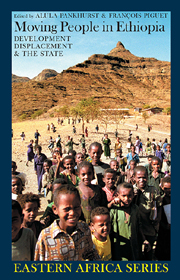Book contents
- Frontmatter
- Contents
- Acknowledgements
- Acronyms
- Glossary
- Notes on Contributors
- Preface: An Original Contribution to Country-wide Displacement Analysis
- Foreword by Alula Pankhurst & François Piguet
- Map
- Part I INTRODUCTION
- Part II THEORETICAL & INTERNATIONAL PERSPECTIVES
- Part III DEVELOPMENT-INDUCED DISPLACEMENT
- 4 Social Dimensions of Development-Induced Resettlement
- 5 The Effects of Development Projects on the Karrayu & Afar in the mid-Awash Valley
- 6 The Effects of Investment on the Livelihoods of the Tsamako in the Wayto Valley
- 7 Planning Resettlement in Ethiopia
- 8 Urban Development & Displacement of Rural Communities around Addis Ababa
- Part IV THE EXPERIENCE OF STATE-ORGANIZED RESETTLEMENT
- Part V THE DILEMMAS OF REFUGEES, RETURNEES & DISPLACED GROUPS
- Part VI CONCLUSION
- Bibliography
- Index
- EASTERN AFRICAN STUDIES
7 - Planning Resettlement in Ethiopia
from Part III - DEVELOPMENT-INDUCED DISPLACEMENT
Published online by Cambridge University Press: 05 April 2013
- Frontmatter
- Contents
- Acknowledgements
- Acronyms
- Glossary
- Notes on Contributors
- Preface: An Original Contribution to Country-wide Displacement Analysis
- Foreword by Alula Pankhurst & François Piguet
- Map
- Part I INTRODUCTION
- Part II THEORETICAL & INTERNATIONAL PERSPECTIVES
- Part III DEVELOPMENT-INDUCED DISPLACEMENT
- 4 Social Dimensions of Development-Induced Resettlement
- 5 The Effects of Development Projects on the Karrayu & Afar in the mid-Awash Valley
- 6 The Effects of Investment on the Livelihoods of the Tsamako in the Wayto Valley
- 7 Planning Resettlement in Ethiopia
- 8 Urban Development & Displacement of Rural Communities around Addis Ababa
- Part IV THE EXPERIENCE OF STATE-ORGANIZED RESETTLEMENT
- Part V THE DILEMMAS OF REFUGEES, RETURNEES & DISPLACED GROUPS
- Part VI CONCLUSION
- Bibliography
- Index
- EASTERN AFRICAN STUDIES
Summary
Background
This chapter is a case study of how resettlement was planned in Ethiopia in relation to the Guji-Oromo of the Nech Sar National Park. In 1994 the Federal government signed an agreement with the European Union for a project to rehabilitate three National Parks in Southern Ethiopia: Nech Sar, Mago and Omo, in order to (a) improve the long-term security and integrity of the country's wildlife resources and protected areas; (b) optimize benefits from the exploitation of natural resources by way of sustainable development and management initiatives; and (c) improve the longterm wellbeing of the local people through their participation in these initiatives.
The Southern Ethiopia National Parks Rehabilitation Project (SENPRP) was a five-year project, originally envisaged in two phases. A two-year preliminary phase was to pave the way for substantial assistance by the European Union to rehabilitate the parks as protected areas with emphasis on development for tourism. Implementation of the main phase of the project was to depend on a number of preconditions to be fulfilled on the Ethiopian side, among them: (a) the finalization of a wildlife conservation policy, which the Federal government should formally adopt and promulgate; (b) the early gazetting of the three project National Parks; and (c) the resettlement of the people living in and around the parks.
- Type
- Chapter
- Information
- Moving People in EthiopiaDevelopment, Displacement and the State, pp. 93 - 101Publisher: Boydell & BrewerPrint publication year: 2009



